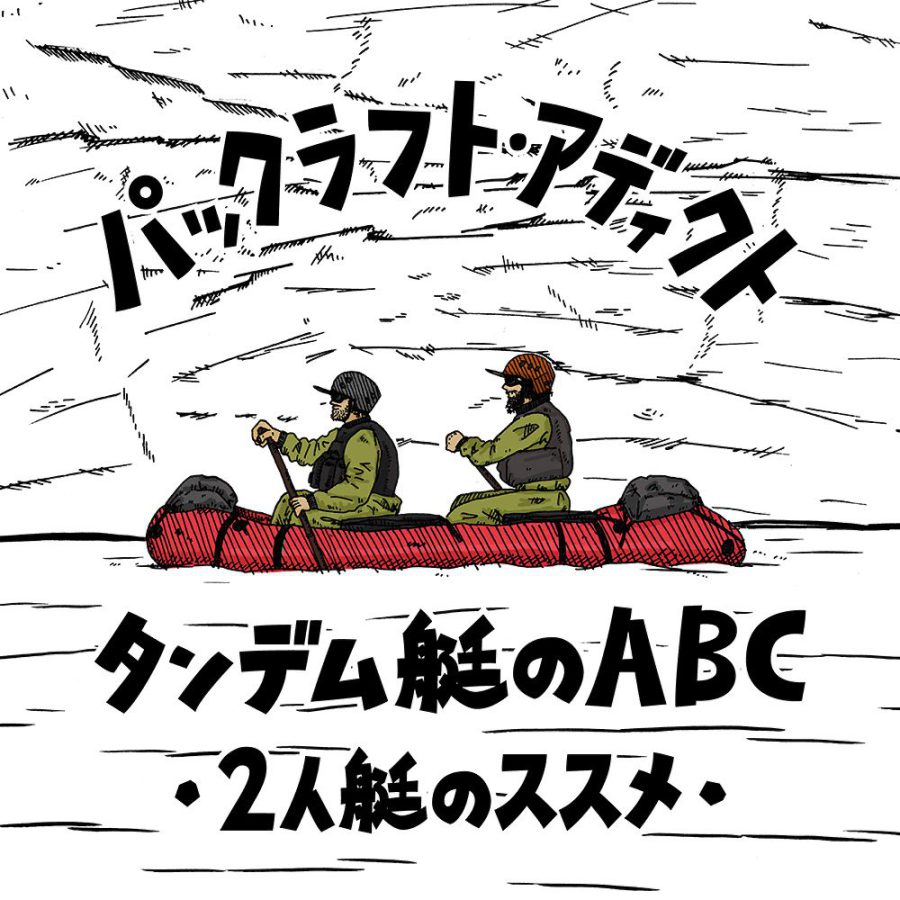パックラフト・アディクト | #58 ポーランドのブダ川、ソロ・パックラフティング3DAYS

Paddling The Wda River in Poland
For the May holidays this year, we went to Poland to visit my wife’s family. But this time we did not stay in Poznan as usually and, instead, booked a hotel in so-called the Tuchola Forest, which is the largest woodland in Poland. The idea was that my wife, her mom, and our daughter would enjoy exploring the area (it turned out that my mother-in-law had never been there), while I go packrafting for several days – a true win-win situation so to speak. And that was what we did.

The river that I paddled this time was the Wda. This is the biggest river in the area and one of the 15 main canoe trails in Poland. It begins its course at Krążno Lake and flows for 198 km until it reaches the Vistula in the town of Świecie. Although the Wda flows through the lowlands, it is characterized by a large meandering. Its sandy banks are mostly covered with forest and can often be high and steep. In some places it even feels as if you are paddling though a gorge.

Though there are six hydroelectric power plants, the river still mostly preserved its natural character. As a matter of fact, over 30% of the Wda’s length lies in nature protection areas, which include two landscape parks and several nature reserves. For all these reasons, the river is very popular among all kinds of paddlers, which is attested by the presence of numerous private and public campsites. The latter are offered by the PTTK, Polish Tourist and Sightseeing Society, and can be used free of change. I have already used some of them during last year’s paddling trip on the Brda (please see my previous articles).

As I only had three days, I could not paddle the whole length of the river and chose a 70 km stretch from Osowo Leśne (113 km from the confluence with the Vistula) to Tleń (43 km from the confluence), which is probably the most beautiful section of the Wda anyways.
(Coincidentally, I paddled a short stretch of it ending also in Tleń, when my wife and I visited the area in 2017.) Over these 70 km the river flows through the Tuchola Forest and there are just a handful of villages on the way. What’s more, there are no real lakes at this section, which makes paddling significantly more enjoyable as there is always some current to help you.
The speed of the flow varied though. While the Wda was mostly 15-20 meters broad, sometimes it would become narrower, and the river would speed up a bit. In other places, it would become a wide slow-moving river. Just before the takeout point in Tleń, the Wda gradually, almost imperceptibly, turns into a long and very shallow arm of the Źurskie Lake. But even here, the current does not disappear completely.

Even though it had not rained much in the weeks before the trip, there was definitely enough water. Though relatively shallow, the sandy bottom is not visible as the water is far from being transparent. As a matter of fact, another name for the river is the Czarna Woda, which means “Black Water.” It comes from the color of the river’s water, which is dark brown, and sometimes almost black. The color is said to be influenced by marshy banks, the number of mineral compounds carried by the water, and, in the past, sludge from tar factories, which existed in villages and hamlets adjacent to the river until the 19th century. And while I would not drink the water from the river, it is definitely not as polluted as it used to be the proof of which is the abundance of wildlife or traces of it.

When talking about wildlife, the first and most visible representative is the beaver, whose traces were omnipresent. Be it an old hut/burrow in the bank, a beaver slide, a gnawed-on tree or debarked twigs, I could see them everywhere for the whole duration of my three-day trip. Still, to my surprise I did not encounter a single beaver even once (not even a splash), which was almost statistically improbable. And disappointing. During the first evening I did hear a gnawing sound next to the river. When I went to check it out, I could not see anything though.

What I did see (and also hear) were all kind of birds. From large common European cranes to tiny songbirds the names of which I do not know – this area was an avian paradise. Some most notable encounters included a kingfisher, which suddenly appeared on a tree brunch from seemingly nowhere and immediately took off as it realized that I was just 1.5 meter away – both of us were a bit surprised to see each other. (I later read that these birds nest in burrows and a high sandy bank next to that place was just a perfect spot for one.)

Another encounter was with a majestic white-tailed eagle, which is the largest breeding bird of prey in Poland. It is also culturally and symbolically very important as it is the representation of this eagle that is depicted on the Polish court of arms. The eagle took flight when it spotted me, but I still managed to snap a couple of pictures before it disappeared behind the trees.

Another bird of prey was a western marsh harrier. Whenever my packraft approached it, this bird would almost unwillingly and, somehow even lazily, fly to another tree next to the water a bit further downstream just to repeat this maneuver once I was close by again. Though it was not my intention, this lasted for quite a while, before the river turned away from the trees and I could pass the bird at what it must have considered a safe distance.

I had exactly the same trouble with plentiful common goldeneyes and goosanders, who I shared the river with. Whatever I tried to do (paddle on the other side of the river, avoid looking at them or even stop paddling altogether and letting the current propel me) it was all for naught as birds would get spooked and fly a bit further downstream, where I would catch up with them again. Sometimes, I would ‘collect’ five or six couples like this. (To my surprise, the common mallards that are plentiful there as well would relatively quickly recognize the direction of my movement and fly upstream – cleaver birds!)

The final two notable ‘close’ encounters were with two mute swans. The first of one I met at the end of the first day and it wanted to pick a fight with me. This time, I was the one being chased by a bird (ironic, isn’t it?). The second one, however, was not aggressive and was just peacefully circling around me until I reached the takeout point in Tleń on Day 3. As it did not want to leave and still hung around while I was packing in my stuff, it occurred to me that this swan was actually begging for food this way.

I suppose the bird got used to being fed by the swarms of water tourists, who must be passing there during high season (summer?). However, I was quite lucky as I had the whole river almost for myself – I only met two groups of people in plastic kayaks. The first ones looked like day-trippers, whereas the other ones were on a multiday trip. I met this group in the morning of the second day when they were just packing up the camp up and, later the same day, when they caught up with me at what I personally consider the most interesting part of the river – the Krzywe Koło nature reserve.

The name literally means “Crooked Circle” and it results from the amazing shape of the boundaries of this reserve, which is defined by the natural bed of the river. It surrounds the reserve almost entirely, leaving only a narrow passage of roughly 5 m wide connecting the reserve with the mainland. Thanks to this, something similar to a “peninsula” is created. This narrow passage makes an amazing impression. It is a narrow path at the top of a high escarpment where you can see the calmly flowing and winding river Wda from both sides, its twisted loop running almost a complete circle.

Even though there were a lot of commercial and public campgrounds on the way (even on the other bank opposite the Krzywe Koło natural reserve) , I chose to camp wild – whenever I am out of the strictly-regulated and overpopulated Netherlands, if I have a choice between wild camping and organized spots, I always prefer the former.

The first night I spent on a meadow next to the river (where I think I heard that beaver). That spot was very nice as the grass had not grown much yet, there was some dry firewood for my woodburning stove, and I had the sun until the very last moment. For the second night I found a nice camping spot as well. It was on a sandy bank with pine trees (I used pinecones for the stove this time). Judging by a couple of fire rings, this was a popular place for wild camping. Or maybe for fishermen – I saw one just a few hundred meters upstream.

In general, the first day I paddled 23 km in 5.5 hours. The second day I did 35 km in under 8 hours. And the last day I did 12 km in just over 2 hours.

As I had made an appointment with my wife for her to pick me up in Tleń at 10 am (we were going home after that), I had an early start the last day. It was a cold but still a truly magical morning. When I left just before 7 am, the river was covered in fog, through which the sharp rays of the morning sun were trying to warm me up. Still, I was happy I had a buff with me. Though by the time I reached Tleń, it became rather hot, and I managed to dry my packraft and other gear before my wife came with our daughter to pick me up (all the while entertaining the swan, who was still asking for food).

Before we said goodbye to the river and the Tuchola Forest, we popped in the building of a hotel/restaurant/brewery, which is just next to the takeout point, where we got a couple of interesting souvenirs – some local special beers (one of which was with the pine tree flavor! – apparently very tasty according to my wife) and some wild strawberry jam with honey.
All in all, it was a lovely 3 days on the water on my own, which helped me to recharge the batteries, see and experience new things, and allowed me to spend some quality time doing what I like the most – packrafting.

- « 前へ
- 2 / 2
- 次へ »
TAGS:














 ULギアを自作するための生地、プラパーツ、ジッパー…
ULギアを自作するための生地、プラパーツ、ジッパー…  ZimmerBuilt | TailWater P…
ZimmerBuilt | TailWater P…  ZimmerBuilt | PocketWater…
ZimmerBuilt | PocketWater…  ZimmerBuilt | DeadDrift P…
ZimmerBuilt | DeadDrift P…  ZimmerBuilt | Arrowood Ch…
ZimmerBuilt | Arrowood Ch…  ZimmerBuilt | SplitShot C…
ZimmerBuilt | SplitShot C…  ZimmerBuilt | Darter Pack…
ZimmerBuilt | Darter Pack…  ZimmerBuilt | QuickDraw (…
ZimmerBuilt | QuickDraw (…  ZimmerBuilt | Micro Pack …
ZimmerBuilt | Micro Pack … 














